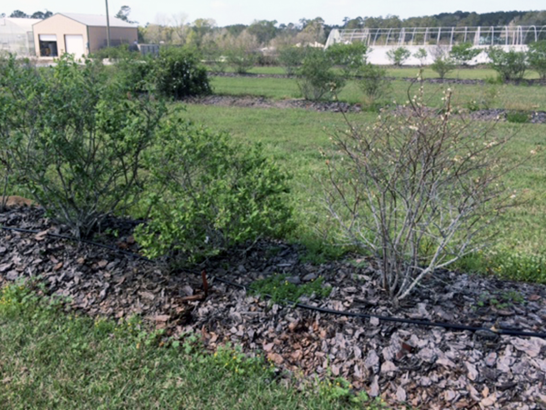Chilling-Hour Requirements of Fruit Crops
What Is a Chilling Requirement and Why Is It Important?
Many temperate, deciduous fruiting plants require a chilling period to break dormancy, grow, and fruit normally. This is why choosing species and varieties that are satisfied by climatic conditions in a specific geographical location is important to achieve the best results.
Plants begin to enter a resting period called dormancy when temperatures fall below 50°F for an extended period of time. Some species and varieties within a species may react to reduced day lengths as well as temperatures. Aboveground growth ceases and leaf fall occurs which signals an entry into dormancy. Hormonal changes in the plant, especially a decrease in growth-promoting hormones, prepare it for cold temperatures. Once into dormancy, chilling accumulation starts and continues until the plant’s required amount is satisfied. After the plant has the required amount of chilling accumulation, growth-promoting hormones increase, preparing the plant for the onset of warmer temperatures.
Stages of Dormancy
Fruit crops go through three main physiological stages during dormancy. The first stage is acclimation, which is the ability to adjust to climate change. Acclimation begins after the plant has ripened its crop and growth has stopped, which is usually late summer into early fall. In order to reach full acclimation, a period of cool weather is required before the first freeze. Acclimation occurs mainly during October and November, although it can begin earlier, especially if the plant is responsive to decreases in day length.
The second stage of dormancy is the ability to survive particular climatic adversities, especially freezing temperatures. This stage generally occurs from December through February. During winter, there are two distinct types of dormancy: endo-dormancy and eco-dormancy. Endo-dormancy is the period when the plant accumulates its chilling hours the most. Until the plant satisfies its need for cold, it will not break bud, even if temperatures warm. Once the chilling requirement for a plant has been satisfied, it enters into eco-dormancy (also called quiescence).
In this stage, the plant is prohibited from growing by the cold temperatures of winter. Once warmer temperatures become more common, the plant transitions into the third stage.
The third stage is called deacclimation. Deacclimation is the process of breaking dormancy and readjusting to warmer temperatures. This process begins with periods of temperatures above 40°F and occurs fairly quickly. Growing-degree days accrue just like chilling hours and eventually lead to bud break once enough heat is accumulated. Deacclimation usually occurs in the spring, but warm temperatures in winter can cause early deacclimation, leading to severe damage when cold weather returns, especially in plants with low chilling-hour and growing-degree-day requirements.
Fulfillment of Chilling Hour Requirement
Typically, temperatures between 32°F and 50°F can help fulfill the chilling requirement of many plants, but the most efficient temperatures for satisfying a plant’s need for cold are between 32°F and 45°F. When temperatures dip below 32°F, very little, if any, chilling is received by the plant. Conversely, when temperatures exceed 60–70°F for extended periods, chilling can be negated. Interestingly, leaf and fruit buds on the same plant can have different chilling requirements (Figure 1). Insufficient chilling can lead to various problems, including delayed foliation, reduced fruit set, and poor fruit quality.

Some fruit plants have a high chill-hour requirement, whereas others have low to no chill-hour requirements (Table 1).
Table 1. Average chilling-hour requirements for various fruit and nut crops common in Mississippi. Actual hours needed depends on variety.
|
Fruit Crop |
Chilling Hours Required |
|---|---|
|
Apples |
200–1,000 |
|
Blackberry |
200–600 |
|
Blueberry |
150–700 |
|
Citrus |
0–100 |
|
Fig |
100–200 |
|
Grape |
100–600 |
|
Peach |
200–800 |
|
Pear |
400–900 |
|
Pecan |
300–500 |
|
Persimmon |
200–400 |
|
Plum |
400–700 |
|
Pomegranate |
100–200 |
|
Strawberry |
200–400 |
Models to Estimate Chilling
Different models exist to estimate chilling. One model defines a chill hour as each hour below 45°F starting on October 1. This works for locations where temperatures below 32°F are rare. Another model uses the number of hours spent between 32°F and 45°F, which are then added to get the total number of chill hours for a season. Other models exist, and different species may require different models.
The most accurate measurement of chill hours is from a device within the field where a plant is growing; however, the cost of the equipment required to measure chill hours can be too high for some growers. MSU Extension created a free, web-based application that uses actual weather data from the nearest weather station to help Mississippi fruit growers estimate chill-hour accumulation for a particular location. This information can help growers assess the growing conditions that impact plant physiology and prepare for events in the upcoming season. The application is available at https://webapps.msucares.com/chill_hours/ (Figure 2). Even though data used by this application is based on actual measurements, results should be considered as general guidelines and not as exact values because weather varies from location to location.

Publication 3067 (POD-04-23)
By Eric T. Stafne, PhD, Extension and Research Professor, Coastal Research and Extension Center.
The Mississippi State University Extension Service is working to ensure all web content is accessible to all users. If you need assistance accessing any of our content, please email the webteam or call 662-325-2262.


